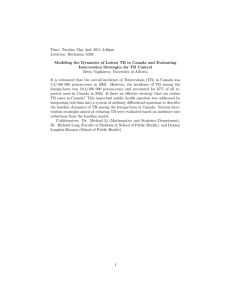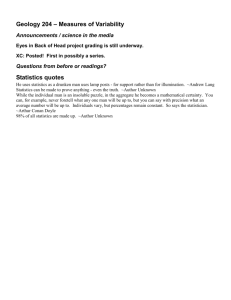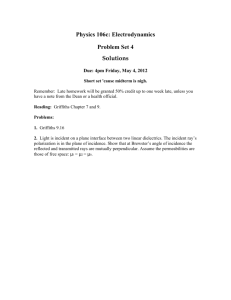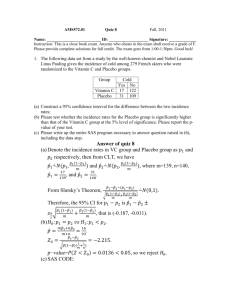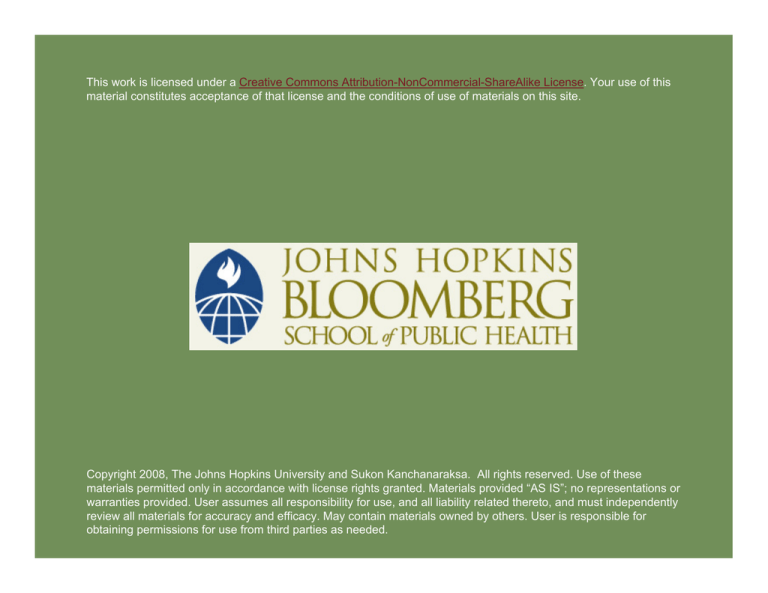
This work is licensed under a Creative Commons Attribution-NonCommercial-ShareAlike License. Your use of this
material constitutes acceptance of that license and the conditions of use of materials on this site.
Copyright 2008, The Johns Hopkins University and Sukon Kanchanaraksa. All rights reserved. Use of these
materials permitted only in accordance with license rights granted. Materials provided “AS IS”; no representations or
warranties provided. User assumes all responsibility for use, and all liability related thereto, and must independently
review all materials for accuracy and efficacy. May contain materials owned by others. User is responsible for
obtaining permissions for use from third parties as needed.
Interaction
Sukon Kanchanaraksa, PhD
Johns Hopkins University
What Is (Biological) Interaction?
Interaction involves two risk factors (and their effect on one
disease outcome)
If the effect of one risk factor is the same within strata defined
by the other, then there is NO interaction
When the effect of one risk factor is different within strata
defined by the other, then there is an interaction (biological)
3
Example of (Biological) Interaction
Cigarette smoking and radon exposure are two possible risk
factors for lung cancer
− Is there an interaction (biological) between cigarette
smoking and radon exposure with regard to lung cancer?
− If the risk of lung cancer from cigarette smoking is the
same among those who were exposed to radon and
those who were not exposed to radon, then there is no
interaction (biological) between the two risk factors
− If the risk differs in the two groups, then there is an
interaction
How do we measure or check for the presence/absence of an
interaction?
4
Measures of Interaction
There are two ways that we measure risk
1. Ratio of risks
2. Difference of risks
(Statistical) interaction can be measured based on the ways
that risks are calculated (modeling)
− When ratio is used, risks are considered to act in a
multiplicative way
− When difference is used, risks are considered to act in an
additive way
The presence of interaction based on measurements is called
statistical interaction, and inherently it may not reflect the
true biological interaction
5
(Statistical) Interaction or Effect Measure Modification
(Statistical) interaction occurs when the incidence of disease
in the presence of two or more risk factors differs from the
incidence expected to result from their individual effects
Source: MacMahon, 1972
6
Implications of Interaction
Synergism increases disease risk beyond expected; persons
with one exposure (smoking) are more susceptible to another
exposure (radon)
Antagonism decreases disease risk beyond expected;
persons with one exposure (smoking) are less susceptible to
another (radon)
7
Hypothetical Data in an Additive Model
Incidence
Factor A
–
+
–
3
9
+
15
?
Factor B
8
Subtracting Baseline Risk from Each Category
Incidence
Factor B
–
+
Factor A
–
+
3
9
15
?
Risk Difference
(Attributable
Risk)
Factor B
Factor A
–
+
–
0
6
+
12
?
9
What Is the Expected Incidence of A+B in an Additive
Model?
Incidence
+
A
=
B
?
A+B
10
What Is the Expected Incidence of A+B in an Additive
Model?
+
=
Incidence
A
B
A+B
Baseline
11
What Is the Expected Incidence of A+B in an Additive
Model?
21
9
3 Baseline
15
6
6
9
12 =
+ 15
12
?
3
3
3
A
B
A+B
12
Expected Incidence in an Additive Model
Expected incidence of A and B = Attributable risk of A alone
+ attributable risk of B alone
+ baseline
= Incidence of A alone
+ incidence of B alone
– baseline
13
Hypothetical Data in an Additive Model
Incidence
Factor B
–
+
Factor A
–
+
3
9
15
21
If there is no interaction between Factors A and B, the
incidence of having A and B is expected to be 21
If the observed incidence in the group having A and B differs
from 21, then there is an interaction (statistical) under the
additive model
14
Test for the Presence/Absence of Interaction
Incidence
Factor B
No interaction:
Synergistic interaction:
Antagonistic interaction:
–
+
Factor A
–
+
I10
I00
I01
I11
I11 – I01 = I10 – I00
I11 – I01 > I10 – I00
I11 – I01 < I10 – I00
15
Smoking and Radon Exposure In Uranium Miners
Smoking
Radon
Lung Cancer
Incidence
No
No
1/1000
No
Yes
5/1000
Yes
No
10/1000
Yes
Yes
50/1000
16
Smoking and Radon Exposure in Uranium Miners
Incidence
Radon
–
+
Smoking
–
+
1
10
5
50
If there is no interaction between smoking and radon
exposure, the incidence of having both is expected to be:
(5–1)+(10–1) +1 = 14
(or, 5 + 10 –1 = 14)
But observed incidence is 50/1000; therefore, there is a
synergistic interaction in the additive model
17
Using the Test Equations
Incidence
Radon
–
+
Smoking
–
+
1
10
5
50
I11 - I01 > I10 - I00
50 - 5 > 10 - 1
Suggests synergistic interaction
18
Same Hypothetical Data in a Multiplicative Model
Incidence
Factor A
–
+
–
3
9
+
15
?
Factor B
19
Calculating Ratio of Risk or Relative Risk in a Multiplicative
Model
Incidence
Factor B
–
+
Factor A
–
+
3
9
15
?
Dividing by baseline incidence of 3
Relative Risk
Factor A
–
+
–
1.0
3.0
+
5.0
?
Factor B
20
Expected Relative Risk for A+B in a Multiplicative Model
Expected RR for A+B = RR for A only x RR for B only
21
The Expected RR for Having Factors A and B in a
Multiplicative Model
Relative Risk
Factor A
–
+
–
1.0
3.0
+
5.0
?
15.0
Factor B
The expected RR for having both A and B = 3.0 x 5.0 = 15.0
The incidence of having both A and B
= baseline I x RR
= 3 x 15.0 = 45
22
Types of Interaction
If the observed risk (or incidence) for having both A and B
is equal to the expected, then there is no interaction
If the observed risk (or incidence) for having both A and B is
greater than the expected risk (or incidence), then there is a
synergistic interaction
If the observed risk (or incidence) for having both A and B is
less than the expected risk (or incidence), then there is an
antagonistic interaction
23
Test for the Presence/Absence of Interaction in a
Multiplicative Model
Relative Risk
Factor B
–
+
No interaction : RR11 =
Factor A
–
+
RR00 RR10
RR01 RR11
RR10 x RR01
Synergistic Interaction : RR11 > RR10 x RR01
Antagonistic interaction : RR11 < RR10 x RR01
24
Example: Relative Risk of Oral Cancer from Smoking and
Alcohol Consumption
Relative Risk
Alcohol
Consumption
Smoking
No
Yes
No
1.00
1.53
Yes
1.23
5.71
Rothman K, Keller A. (1972). The effect of joint exposure to alcohol and tobacco on risk of cancer of the mouth
and pharynx. J Chronic Dis 25:711-716.
25
Example: Relative Risk of Oral Cancer From Smoking and
Alcohol Consumption
Relative Risk
Alcohol
No
Smoking
No
Yes
1.00
1.53
Yes
1.23
5.71
1. The expected RR for smoking and drinking alcohol
= 1.53 x 1.23 = 1.88
2. Using the test equation to check for interaction
5.71 > 1.53 x 1.23
Suggest synergistic interaction in the multiplicative model
26
Use of Relative Risk in an Additive Model
1. Incidence
Factor B
–
+
3. Relative Risk
Factor B
Factor A
–
+
3
9
15
21
2. Attributable
Risk
Factor B
–
+
Factor A
–
0
12
+
6
18
Factor A
–
+
–
1.0
3.0
+
5.0
7.0
27
Use of Relative Risk in an Additive Model
1. Incidence
Factor B
–
+
3. Relative Risk
Factor B
Factor A
–
+
3
9
15
21
Factor A
–
+
–
1.0
3.0
+
5.0
7.0
2. Attributable
Risk
Factor B
–
+
Factor A
–
0
12
+
6
18
No interaction :
(1)
I11 - I01 = I10 - I00
No interaction :
(2)
RR11 - RR01 = RR10 - RR00
(3)
RR11 - RR01 = RR10 - 1
(4)
RR11 = RR01 + RR10 - 1
28
Example of Interaction
Effect of aflatoxin in chronic hepatitis B patient on the
development of liver cancer
− RR of liver cancer from hepatitis B infection alone was 7.3
− RR of liver cancer from aflatoxin exposure alone was 3.4
− RR of liver cancer from both was 59.4
Qian GS, Ross RK, Yu MC, et al. (1994). A follow-up study of urinary markers of aflatoxin
exposure and liver cancer risk in Shanghai, People’s Republic of China. Cancer Epidemiol
Biomarkers Prev 3:3-10.
29
Statistical Interaction versus Biological Interaction
Is the presence of a biological interaction between two risk
factors based on the expectation that the risk factors should
interact following an additive or a multiplicative model? Or,
should it be based on a special law of biology that is more
complex than the measurement tools (modeling) available?
The answer will likely require a better understanding of the
underlying biological mechanisms of disease causation and
the causal (or risk) factors
Since several factors play a role in disease causation, it is
important to understand the concept of interaction—
especially in individuals with multiple risk factors
30


